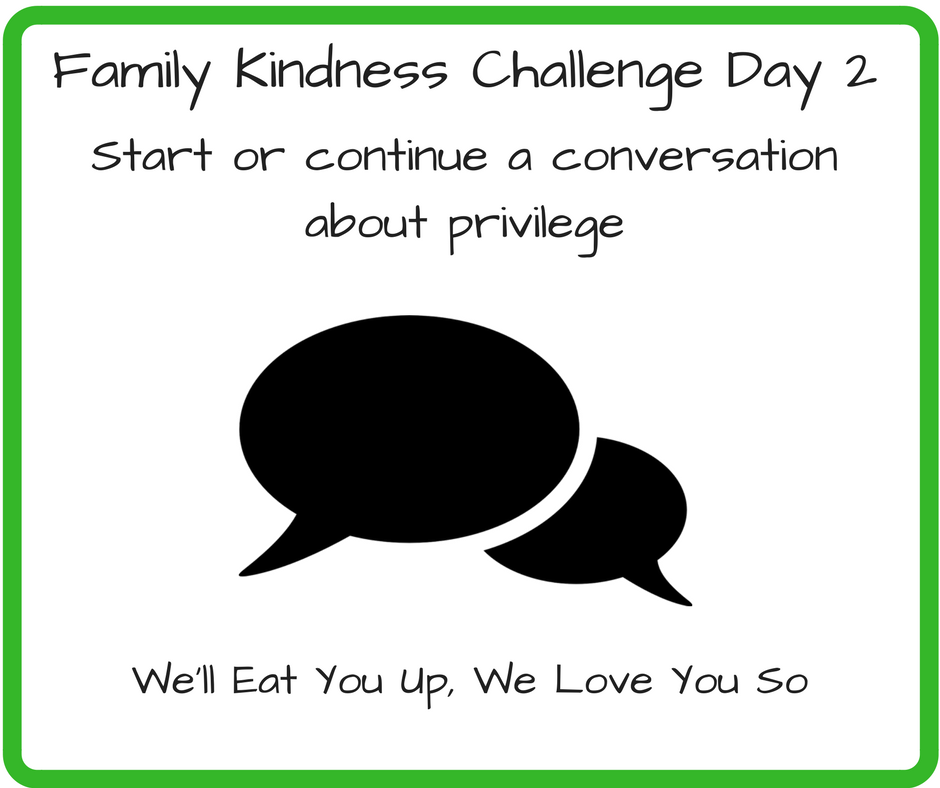
The Activity:
Just like peace isn’t an absence of war, true kindness isn’t just “being nice” to people. It’s also about showing all people respect, making freedom from hate a reality, and providing access to opportunity. While individual actions are great, breaking down systems of inequality and injustice are essential.
A big piece of learning to be kind is understanding your own privilege. Although this can feel like a tough topic to parents, kids understand it better than we give them credit for. It’s tempting to think “just let kids be kids,” but parents of kids who aren’t privileged – like LGBT parents, parents of black kids, poor, and/or non-Christian kids – don’t get that luxury.
The first step is simply stating that some people have advantages over others in society. The classic text for understanding privilege is White Privilege: Unpacking the Invisible Knapsack, but I find it a little difficult to wrap my own head around that article.
Instead, I rather like “The Dollar Bill Hanging from the Ceiling” exercise that Bailey Koch describes on the website Her View from Home. In it, she hangs two dollar bills from the ceiling and then invites two kids – one much taller than the other – up to grab them. The kid who grabs theirs first gets to keep both dollars. Of course, the tall kid grabs it first and receives both bills. Right away, kids realize that even though both kids have access to the same thing, they have different opportunities. She then goes back and gives the shorter kid a chair to stand on, making it so both students have the same opportunity. While she uses the dollar bill exercise to illustrate how students start with certain academic advantages or not, I think it’s a great physical illustration of privilege out of the classroom as well.
If you relate to video games, John Scalzi’s Lowest Difficulty Setting is a great metaphor. The article makes it clear that having privilege of any kind doesn’t mean things will always be easy. In fact, you’ll almost certainly encounter things that are hard. But if you’re privileged, those things won’t be as hard to handle as someone in a less privileged position.
Obviously, the conversation here is going to vary widely depending on the age of your child. For our four-year-old, it’s a simple as telling him that people have different lives than we do. Some people have less money, some people have difficulty walking, some people don’t celebrate Christmas, some people have different color skin than we do. We’ve also edged a bit into the fact that people treat others worse because of these differences. If nothing else, his constant questioning “Why?” has forced our hand in the best way possible. The more we as adults think “Why?” about systems we take for granted, the more we can break them down and build something better in their place.
The next step to understanding privilege is seeing how someone can be privileged in one area and not in another. Similarly, someone can be non-privileged in several ways that interact with each other. For example, a black woman is treated differently (and often worse) by society than either a black man or a white woman is. This is called intersectionality. This comic does a great job breaking down intersectionality and what it means for people.
What types of privilege you discuss obviously depends on your own circumstance. For us, economic privilege is the easiest to start with because it’s easy to see how some people have less money and the material impact that has on their lives. With race, we’re talking about the history of the Civil Rights movement and starting to provide some modern-day context about the work that still needs to be done.
The resources you can turn to depends on the sort of privilege. There are a ton of great resources for talking to kids about race: Raising Race Conscious Children, Embrace Race, and Raising an Advocate. Some of the other topics don’t seem to have as many good resources available, unfortunately.
This is a tough thing to tackle, so good luck!
Our Experience:
I admit that I completely forgot about this until we were smack in the middle of bedtime. Nonetheless, I took a break from reading books for a heart-to-heart conversation. Or as it turned out to be, a heart-to-foot conversation.
I started off with the economic privilege part. “You know that we’re really lucky to never have to worry about food to eat. Some people have to worry about that. And we’re really lucky to have a house. Not everyone has that.”
“Uh huh.”
“And clean water.”
“What’d you say?” he responded.
“Remember when we talked about not everyone has toilets? Some people have water that makes them sick when they drink it.”
Silence.
“And you know what? Some people treat other people differently because they have less stuff. Or because of the color of their skin. Or because they don’t believe in Jesus. Is that fair?”
“No, it’s not.”
“And it’s not always even on purpose. Sometimes they don’t even realize they’re doing it.”
Just then, I noticed he was licking his finger, rubbing his foot and then sticking his finger back in his mouth. “I’m making my foot all wet,” he informed me.
I decided to ignore that. Interest was clearly fading so I wrapped it up. “So we need to be kind to everyone. And if you hear someone say that they’ve been treated differently than you, you need to listen and just be a good friend.”
Listening well is the number one lesson I’ve learned in all of my activism work. I hope he can learn it faster than I did.
“To be a good friend, yep.”
Then he stuck his foot in my face. That was the end of that deep conversation. Four-year-olds!
wonderful; and creatively presented … I will share with daughters – grandkids live so far away.